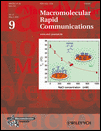Salt-Induced Depression of Lower Critical Solution Temperature in a Surface-Grafted Neutral Thermoresponsive Polymer
Abstract
Summary: Quartz crystal microbalance with dissipation monitoring (QCM-D) is employed to determine the effect of salt on the volume phase transition of thermoresponsive polymer brushes. Changes in mass and viscoelasticity of poly(N-isopropylacrylamide) (PNIPAM) layers grafted from a QCM-D crystal are measured as a function of temperature, upon contact with aqueous solutions of varying salt concentrations. The phase-transition temperature of PNIPAM brushes, TC,graft, quantified from the QCM-D measurements is found to decrease as the concentration of salt is increased. This phenomenon is explained by the tendency of salt ions to affect the structure of water molecules (Hofmeister effect). However, in contrast to the linear decrease in phase-transition temperature upon increasing salt concentration observed for free PNIPAM, the trend in TC,graft for PNIPAM brushes is distinctively non-linear.





